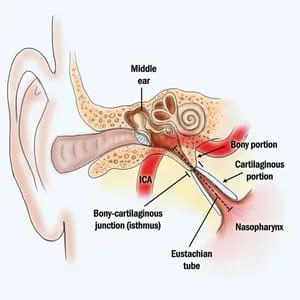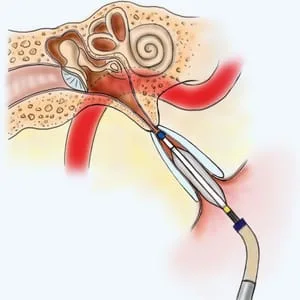Hearing Loss Treatment for Bethlehem, PA Patients
Hearing loss has a lot of different causes and manifestations. It can be sudden or gradual. It can occur in one ear or both ears. It can be temporary or permanent. It happens to people of all ages and is associated with the aging process. Before discussing causes and treatments for hearing loss, it is important to understand how hearing works.
How We Hear
There are three sections of the ear: the outer ear, middle ear, and inner ear. Each section helps move sound through the process of hearing. When a sound occurs, the outer ear feeds it through the ear canal to the eardrum. The noise causes the eardrum to vibrate. This, in turn, causes three little bones inside the middle ear (malleus, incus, stapes) to move. That movement travels into the inner ear (cochlea), where it makes tiny little hairs move in a fluid. These hairs convert the movement to auditory signals, which are then transmitted to the brain to register the sound.
Causes Of Hearing Loss
Hearing loss occurs when sound is blocked in any of the three areas of the ear. The most common cause of hearing loss and one of the most preventable is exposure to loud noises. Infections, both of the ear or elsewhere in the body, are also a major contributor to hearing loss.
- In the Outer Ear: Earwax build-up, infections that cause swelling, a growth in the ear canal, injury or birth defects can restrict hearing in the outer ear.
- In the Middle Ear: Fluid build-up is responsible for the most common infections and blockages in the middle ear. Fluid in the middle ear prevents the bones from processing sounds properly. Tumors, both benign and malignant, can also result in hearing loss in the middle ear.
- In the Inner Ear: The natural process of aging diminishes hearing from damage to the cochlea (mechanism for converting sound vibrations to brain signals), vestibular labyrinth (which regulates balance), or the acoustic nerve (the nerve that sends sound signals to the brain). Additionally, inner ear infections, Meniere's disease, and other nerve-related problems contribute to hearing loss in the inner ear.
Other Causes Of Hearing Loss
- Presbycusis: Age-related hearing loss, such as having difficulty hearing in noisy places, having trouble understanding what people are saying or not registering softer sounds.
- Heredity and Genetic Causes: There is a wide variety of diseases and syndromes that are either genetic or hereditary that can cause hearing loss. Some, like rubella (German measles) occur when a pregnant mother has the disease, which causes hearing loss in the baby. Other, rarer types of hereditary and genetic causes include CHARGE Syndrome, Connexin 26 disorder, Goldenhar Syndrome, Treacher Collins Syndrome, Usher Syndrome, Waardenburg Syndrome and otosclerosis (growth of spongy bone tissue in the middle ear).
Most causes of outer ear hearing loss can be remedied. But problems of the middle and inner ear can lead to permanent hearing loss, which is why it is important to seek medical attention quickly if you are experiencing a problem hearing.
Types Of Hearing Loss
- Conductive hearing loss: Caused by conditions that block the transmission of sound through the outer ear and eardrum to the middle ear.
- Sensorineural hearing loss: Inner ear damage that occurs as part of the natural process of aging.
- Mixed hearing loss: Mixed hearing loss refers to people who have both conductive and sensorineural hearing loss. Most people experience more than one type of hearing loss.
- Central hearing loss: This occurs when the central nervous system fails to send a readable signal to the brain, which is called a central auditory processing disorder. People with central hearing loss generally can hear all sounds, but can't separate or process them.
Hearing loss is measured in four degrees: mild, moderate, severe or profound. The degree of hearing loss drives the selection of the best form of treatment on a case-by-case basis.
Hearing Loss Treatments
The location, type, and degree of hearing loss impact the choice of treatments for any hearing problem. The most common treatment options include:
- Antibiotics, decongestants and pain medication to overcome ear infections.
- Myringotomy with the insertion of tubes to allow for fluids to drain out of the middle ear.
- Balloon dilation of the Eustachian tube (part of the anatomy that connects the middle ear to the back of the throat) to keep it open and allow for normal drainage. This technique may be recommended for people who get frequent ear infections.



- Hearing aids.
After the diagnostic hearing assessment, an appointment will be made with the audiologist for a hearing aid evaluation. The audiologist will discuss the different styles and technologies that are appropriate for your hearing loss. The policies and procedures for dispensing hearing aids, prices, and options will be explained. When selecting a hearing aid, the patient’s lifestyle, age, hearing loss, budget, and expectations are taken into consideration. Hearing aids are fit on a trial basis, with the opportunity to wear the hearing aids for a period of time in multiple environments to help you decide if the aid is appropriate for you. The Head and Neck Center, PC also offers a convenient payment plan to help with the cost of the hearing aid.
When your new hearing aids are ready, you will return to the office for the hearing aid fitting. At this appointment, the audiologist will ensure that your hearing aid feels comfortable and you understand its operation. Extensive counseling on the use and care of the hearing aid will take place at this visit. Follow-up visits will be scheduled if you need further assistance or if the aid needs additional adjustments. You will be encouraged to contact your audiologist with any questions or concerns that you may have about your new hearing aid.Styles Of Hearing Aids





Hearing Aid Technology
The majority of hearing aids dispensed today have digital signal processing. This is the most advanced technology available. Digital programming allows the audiologist to adjust the parameters of the hearing aid through special computer programs. This highly developed signal processing allows manufacturers to create hearing aids with enhanced processing and features.
Today’s hearing aids offer a large number of optional features that help to improve your listening comfort and your understanding of speech. These features are described below:- Gain processing helps to increase the audibility of sounds of interest without discomfort resulting from high-intensity sounds
- Directional microphones help to improve your speech understanding in noisy environments.
- Digital feedback reduction can reduce the annoying squeal that some hearing aids produce, without the reduction in your listening volume. This can substantially benefit users who experience occasional feedback, such as that associated with jaw movement
- Digital noise reduction automatically lowers the hearing aid volume for many types of noises, which may improve your listening comfort.
What To Expect From Hearing AidsIt is likely that your hearing gradually deteriorated over time, so you should not expect your hearing aids to immediately return your hearing to normal. Time and patience are needed to use hearing aids successfully. It is important to tell your audiologist about any problems you are experiencing so appropriate adjustments can be made.
- Surgery to remove benign or malignant tumors or correct bone- or nerve-related problems.
